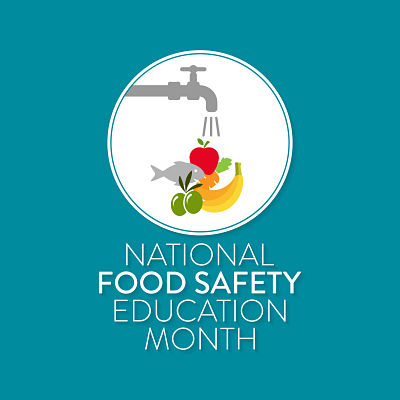
Picture of a water faucet rinsing off fish, grapes, bananas, grapes, carrots, and an apple. It says:
NATIONAL FOOD SAFETY EDUCATION MONTH
SEPTEMBER IS NATIONAL FOOD SAFETY EDUCATION MONTH
According to the Centers for Disease and Prevention, every year an estimated 1 in 6 Americans (or 48 million people) get sick 128,000, are hospitalized and 3,000 dies from eating contaminated food. Anyone can get sick from a foodborne illness (also called food poisoning). To help prevent contracting a foodborne illness, use the four core practices -- clean, separate, cook and chill.
CLEAN
Wash hands and surfaces often. Bacteria easily spreads throughout the kitchen and gets onto hands, cutting boards and about everything else. Wash with warm water and soap for at least 20 seconds, and wash your cutting boards, etc. with hot, soapy water after preparing each food.
SEPARATE
Cross-contamination is how bacteria can be spread. Improper handling of raw meat, poultry, seafood, and eggs can create an inviting environment for cross-contamination. Separate your raw meat, poultry, seafood and eggs from other foods in the shopping cart, grocery bags and refrigerator. Use one cutting board for raw meat, poultry, and seafood and a separate on for fresh produce and never place cooked food on a plate that previously held raw meat, poultry, seafood, or eggs.
COOK
Food is safely cooked when it reaches a high enough internal temperature to kill the harmful bacteria that causes the illness. Always use a food thermometer to check the internal temperature of cooked foods. Use a temperature guideline to determine the temperatures to cook all your meats. Cook eggs until yolk and whites are firm, not runny. Make sure there are no cold spots in food when cooking in a microwave oven.
CHILL
Refrigerate foods quickly because cold temperatures slow the growth of harmful bacteria. Keeping your refrigerator a constant temperature of 40 degrees F or below is one of the most effective ways to reduce the risk of bacteria. Refrigerate your meat and other perishables as soon as you get home from the store. Never defrost food at room temperature. The safe way to defrost is in the refrigerator, in cold water, or in the microwave. Divide your food into shallow containers for quicker cooling in the refrigerator.
Follow these 4 simple core practices and you should be able to get and keep your food safe. If you think you have a foodborne illness, see your local physician or call Sabetha Family Practice at (785) 284-2121 to make an appointment with one of their physicians.
Here's to happy (and SAFE) eating.
